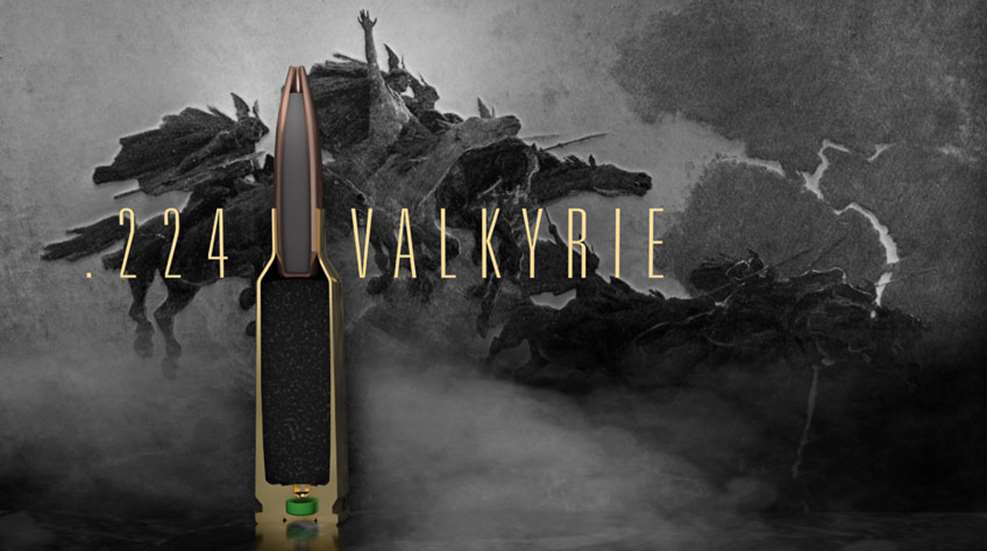
For ardent, long-range enthusiasts and competitors, as well as the cartridge developers who seek to satiate them, the persistent dilemma is in striking a balance between the trinity of ballistics, perceived recoil and platform compatibility. Though many have pursued it, the proverbial Holy Grail has proven elusive—especially for the semi-automatic AR-style rifle. It’s essentially an uncompleted puzzle. Last year, Nosler introduced its solution, the 22 Nosler (July 2017, p. 48), and now Federal has its own.
Prior to the 2018 Shooting, Hunting, Outdoor Trade (SHOT) Show, Federal Premium captured the attention of the media and consumers alike with releases about its new cartridge, the .224 Valkyrie. Billed as “the new choice for both long-range target shooters and hunters,” and described as “an all-new cartridge that transforms the MSR15 platform, unleashes shooters’ long-range potential and shatters the boundaries of ballistic performance,” the cartridge appeared poised to end the search for the elusive ballistic solution. Does it live up to its hype?

Limitations & Developments
For cartridge developers, AR-style platforms epitomize the idiom, “throw a (monkey) wrench into the works.” One-off creations notwithstanding, ARs are proportionately sized to accommodate two families of cartridges, the .223 Rem./5.56x45 mm NATO (AR-15) and .308 Win./7.62x51 mm NATO (AR-10). A distinct exception is the quasi-AR-15-size 7.62x51 mm NATO-chambered Patriot Ordnance Factory Revolution (January 2018, p. 96). To feed reliably from the 5.56 mm NATO magazine, cartridges housed in the AR-15 mustn’t exceed the SAAMI-outlined maximum cartridge overall length (COL) of 2.260", while those in the AR-10 are restricted to 2.810".
The long-range capabilities of the .308 Win., its offspring and the newer 6.5 mm Creedmoor, are well-established. However, an AR-10—the Revolution notwithstanding—in any of said chamberings is, at times, unduly heavy, and the cumulative effects of recoil from such cartridges can prematurely induce shooter fatigue and negatively affect accuracy. On the other hand, an AR in .223 Rem./5.56x45 mm NATO or similar-COL-length cartridges is typically lightweight with minimal recoil, but offers lackluster external ballistics for long-range target engagements. Federal decided a new cartridge was needed.
In developing the .224 Valkyrie, Federal used the 6.8 mm SPC/.30 Rem. case as the foundation. The 0.422"-wide case rim remains unchanged. Moreover, the case is short; it measures a scant 1.60", or 0.160" shorter than that of the .223 Rem. There’s a reason, though, which will be detailed momentarily. A 30-degree shoulder beginning 1.2033" from the base results in a lengthy 0.2689" neck—an asset for aligning and securing streamlined, heavy-for-caliber bullets. The case tapers from 0.4207" ahead of the extractor groove to 0.4031" at the beginning of the shoulder, thereby requiring it to be fed from a 6.8 mm SPC AR-15 magazine. However, the Valkyrie case’s shorter length reduces capacity to 31.5 grs. of water when filled. Despite its small size, the case’s short overall length maximizes usable space by allowing elongated projectiles, such as the 1.155"-long Sierra 90-gr., hollow-point boattail (HPBT) MatchKing, to be seated farther outside the case without exceeding the 2.260" COL. The maximum average pressure (MAP) is kept to 55,000 p.s.i.
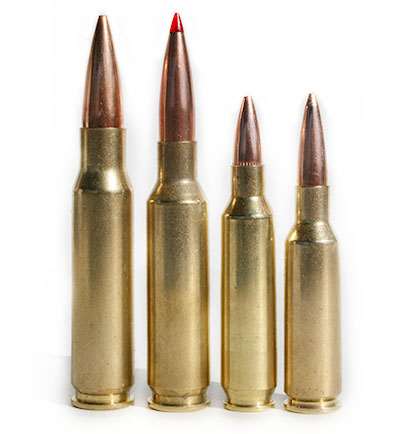
The design isn’t without fault, though; light- to mid-weight bullets—due to their shorter overall lengths, and when seated for sufficient tension—will have sizable jumps to the lands. For example, when loaded with the 0.865"-long Nosler Ballistic Tip Varmint bullet (in the Federal Premium offering), the COL is 2.168", or 0.092" shorter than the maximum COL. In the American Eagle load, the 75-gr. total-metal-jacket (TMJ) bullet is loaded to a COL of 2.135"—a full 1/8" short of the maximum COL. Take into account the leade, too, and that’s quite a jump. In some rifles, it can negatively affect accuracy.
High-ballistic-coefficient bullets are the forte of long-range marksmen, and that’s where the .224 Valkyrie was designed to deliver. The flagship offering for engaging targets at distance is the Gold Medal Sierra MatchKing load, which features the 90-gr. HPBT MatchKing. With a remarkable 0.563 BC and 2700-f.p.s. starting velocity (in a 24" barrel), the bullet remains supersonic out to 1,300 yds. That is important because the transonic zone (where the projectile transitions from supersonic back to subsonic speeds) can cause it to lose stability, thereby negatively affecting accuracy.
Additionally, a faster time to target flattens the trajectory, lessens wind deflection and increases energy, though the latter is a moot point for a target load.
What’s not debatable is a noteworthy reduction in recoil compared to popular long-range loads in both AR-style rifles and bolt-actions, such as the 6 mm Dasher, 6XC, 6 mm Creedmoor, .243 Win., .260 Rem., 6.5 mm Creedmoor, 6.5 mm Grendel and .308 Win., among many others. Since the recoil impulse of a gun is influenced by bullet weight, propellant charge and muzzle velocity, by lessening the former two, perceived recoil is lessened; however, thanks to the high BC of the 90-gr. HPBT MatchKing, external ballistics aren’t sacrificed. You’re getting better ballistics and less recoil.
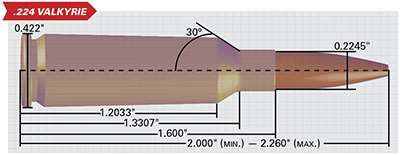
By The Numbers
How does the .224 Valkyrie perform at long range? When zeroed at 100 yds., the 90-gr. HPBT MatchKing—propelled to 2700 f.p.s.—will impact 345.8" low at 1,000 yds., and in a 10-m.p.h. full-value wind, it’ll deflect 80.5" off course. The same bullet isn’t offered in .223 Rem. factory loadings; however, according to Western Powders Reloading & Load Data Guide, Edition 6.0, A-2520 propellant—loaded at 54,416 p.s.i.—will send the same 90-gr. HPBT MatchKing projectile to 2586 f.p.s. At that velocity, the MatchKing will drop 382.4" and veer off course 85.8", which is more than the Valkyrie. Loaded in the higher-pressure 5.56x45 mm NATO cartridge, the same projectile reportedly hits 2701 f.p.s. with a pressure of 60,052 p.s.i.—virtually identical to the .224, so performance will be similar.
The .224 Valkyrie also stacks up favorably with other chamberings common to the AR platform. Take the .308 Win. for example; the Federal Premium Gold Medal MatchKing .308 Win. load propels the 0.505-BC, 175-gr. HPBT MatchKing to 2600 f.p.s., and with a 100-yd. zero it drops 406.7" at 1,000 yds. Wind deflection is 98.5". Also in .308 Win., the Gold Medal Berger load features a 0.552-BC, 185-gr. Juggernaut open-tip-match (OTM) bullet driven to 2600 f.p.s., and at the same distance it impacts 382.4" and is pushed to the side 87.4". Of course, with a larger cartridge comes an attendant increase in recoil and platform cost.
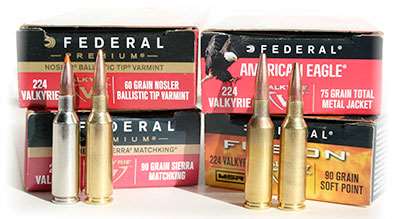
To fulfill the needs and budgets of varied shooters, Federal offers three other loads to complement the 90-gr. HPBT MatchKing. The least expensive option, the target and fur-saving American Eagle load, propels a non-expanding, 75-gr. TMJ bullet to 3000 f.p.s. It produces 1,499 ft.-lbs. of energy at the muzzle. For hunting deer-size game and feral pigs, there’s a 90-gr. soft point option in the Fusion line. Thanks to a muzzle velocity of 2700 f.p.s.—from a 24" barrel, as are the others—and 0.450 BC, it generates 1,457 ft.-lbs. of energy at the muzzle and maintains 500 ft.-lbs. beyond 600 yds. With a 200-yd. zero, it’ll drop 8.5", 24.7" and 50" at 300, 400 and 500 yds., respectively. There’s also a 60-gr. Nosler Ballistic Tip Varmint bullet loaded to 3300 f.p.s.
Alliant Powder currently lists several .224 Valkyrie recipes using the Sierra 90-gr. HPBT MatchKing and Nosler 60-gr. Ballistic Tip Varmint bullets on its website. According to Alliant Powder, when seated atop a maximum charge of Reloder 15 (28.6 grs.)—for a COL of 2.170"—the bullet will achieve 3252 f.p.s from the .224 Valkyrie. But the .224 Valkyrie can top that speed; switching to Alliant 2000-MR will allow it to achieve 3395 f.p.s., which is faster than the factory load. That’s significantly zippier than the .223 Rem., as well. Alliant 2000-MR can also help the 90-gr. HPBT MatchKing hit 2763 f.p.s. in the .224 Valkyrie.
Range Results And Final Thoughts
Testing of the .224 Valkyrie began with an evaluation of accuracy using the American Rifleman protocol of five consecutive, five-shot groups at 100 yds. All four offerings from Federal were on hand for the test. As for the rifle, it was an 18"-barreled Savage Arms MSR15 Valkyrie topped with a Leupold VX-3 8.5-25X 50 mm Long Range scope in a Weaver MSR 1-Piece Scope Mount. For supports, I used a Caldwell 7-Rest and a sandbag.
The first load tested, Federal Premium Gold Medal Sierra MatchKing 90-gr. HPBT MatchKing, proved to be the most accurate by a significant margin. In fact, it produced a 0.34", five-shot group, as well as averaged 0.81" for all 25 shots. As an aside, once testing at 100 yds. was completed, I used this same load at 200 and 300 yds. with parallel outcomes; at 200 yds., the average for three, five-shot groups was 1.21", and at 300 yds. the mean for 15 shots was only 1.76". One five-shot group at 300 yds. measured a scant 0.90"—impressive!
Regardless of the reason—bullet jump, rifling rate of twist, etc.—the results of the other three loads weren’t as rousing as those of the MatchKing load. The 60-gr. Ballistic Tip Varmint, for example, averaged 1.51" for its five, five-shot groups. Although acceptable for perforating paper, such accuracy may be insufficient for long-range shoots on prairie dogs and ground squirrels. The value-priced, American Eagle 75-gr. TMJ load had a mean of 1.80"—good for the wallet but less than ideal for use at extended range. Lastly, the Fusion 90-gr. soft-point round averaged 1.75" for 25 shots, which is acceptable for the ranges at which the .224 should—realistically—be used on deer-size game.
Keep in mind that the results were influenced by a single rifle, and it’s unreasonable to judge a cartridge (or load) based solely on its performance in an isolated test. The accuracy exhibited by the 90-gr. HPBT MatchKing load says much about the cartridge’s potential. It’s there, and no doubt will perform even better out of a true precision rifle.
Despite shooting hundreds of rounds in a single day during sight-in, accuracy testing and chronographing, my shoulder wasn’t the least bit affected, nor was I mentally fatigued; recoil is remarkably minimal given the cartridge’s external ballistics. For the serious competition shooter, that’s no small gain.
Since the Savage Arms MSR15 Valkyrie featured an 18" barrel—as opposed to 24" tubes utilized by Federal Premium ballisticians—velocities were, as expected, lower than published numbers. According to a Competition Electronics ProChrono Digital chronograph placed 15 ft. from the muzzle, the 90-gr. BTHP MatchKing averaged 2565 f.p.s. for 10 consecutive shots, and it had a standard deviation of 15. The 90-gr. SP, 60-gr. Ballistic Tip Varmint and 75-gr. TMJ loads had means of 2589, 3128 and 2873 f.p.s., respectively. Of course, this decrease in velocity will increase the amount of drop at distance. At 37 and 29, the standard deviations of the 75- and 60-gr. loads were notably high.
In the end, anyone seeking streamlined, heavy-for-caliber projectiles for competition, plinking or varminting in an AR-15 platform with minimal recoil will find none better than the .224 Valkyrie. It’s clearly superior to the .223 Rem. Its use in an AR will also surely endear it to international shooters who cannot own such a rifle in a military chambering (i.e. .223 Rem./5.56x45 mm NATO). Additionally, the bolt-action aficionado stands to gain a lot from the cartridge, too. Effectively, its an efficient, low-recoil precision cartridge with significant reach as a factory option. No longer will the shooter need to purchase a semi-custom or custom rifle to seriously compete, and brass will be easy to secure. This will be a turnkey solution for getting started in competition.
Currently, a variety of .224 Valkyrie-chambered rifles are available from Ashbury Precision, Barrett, CMMG, CMT, LWRCI, Larue, JP Rifles, Masterpiece Arms, Mossberg, Savage Arms and Stag Arms, among others. Suggested retail prices for 20-count boxes of the ammunition range from $13.95 (American Eagle) to $31.95 (Gold Medal Sierra MatchKing). Real-world pricing, though, is significantly less. MidwayUSA lists 100-count bags of Federal .224 Valkyrie brass for $29.49.
When it comes to the creation of a long-range-capable, low-recoil cartridge for the AR-15 platform, Federal Premium appears to have solved the puzzle.
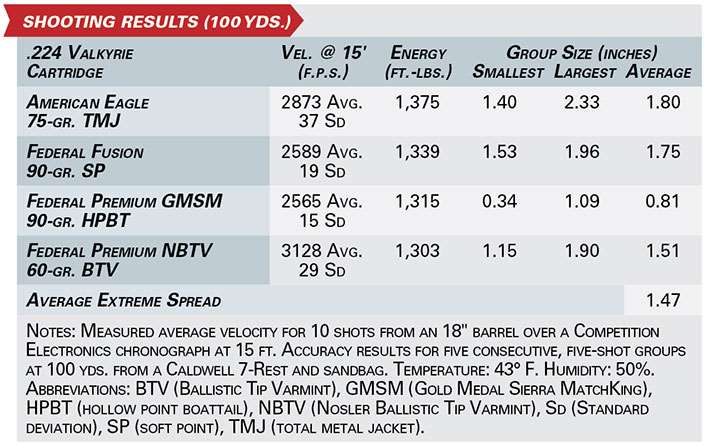
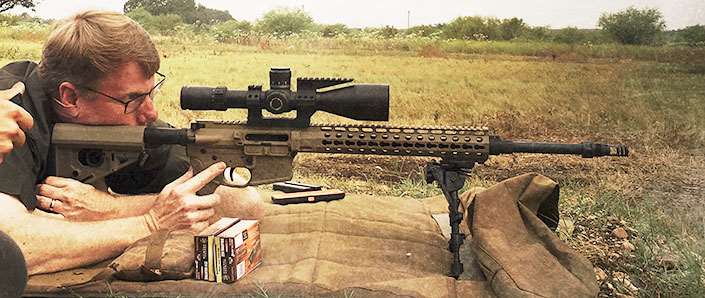
Additional Reading:
The Keefe Report: .224 Valkyrie: The Next Big Thing?





































